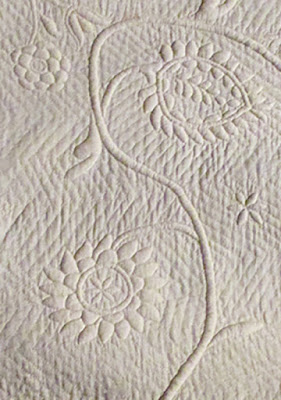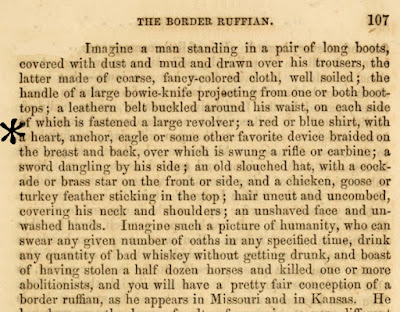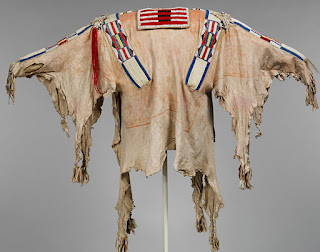Collection of the Arabia Steamboat Museum
Kansas City, Missouri
A shirt that survived an 1856 ship wreck on the Missouri River---
When I first saw this shirt in their display years ago I guessed it was probably in a passenger's luggage rather than on its way to stock a store as were most the surviving objects from the Steamboat Arabia.
It must be wool. Cotton and linen would not have
survived the 150+ years the cargo lay in mud before
being excavated in recent decades.
But now I find they have a stack of these shirts in their cold storage, some awaiting restoration,
others restored (after being in mud without any air/oxygen for 150+ years they would completely
disintegrate if they weren't treated after anaerobic storage.)
The heart on the lower part of the shirt on display
was transferred over the decades from the shirt stacked atop it.
Side fastening shirt with a placket
I'd call it a pullover shirt with a placket that buttons across the chest. Sometimes called a bib shirt.
The embroidery and applique in the top heart look to be white cord secured with thread in a cross pattern plus an added heart outline in the same couching technique.
Couched embroidery. Here a purple yarn is held
down by blue-green thread.
The transferred heart
Why that heart would imprint on the next shirt in the stack is a mystery to me.
Label in the museum's display
The
Arabia sunk in 1856; a year later Dr. John H. Gihon described such a shirt in his history of the Kansas Territory during friend Governor John W. Geary's tenure. The territory, only 3 years old, suffered much from pro- and anti-slavery partisans.
Pennsylvanian Dr. John Hancock Gihon 1811-1875) was secretary to the Governor. His son John Lawrence Gihon (1839-1878) was his assistant. The elder Gihon wrote about Missourians who came into Kansas to vote illegally and intimidate voters and settlers.
"Imagine a man [in] a red or blue shirt, with a heart,
anchor, eagle or some other favorite device
braided on his breast and back."
Imagine a man....
I found the photo of the Confederate soldier on an Instagram page CivilWarMemory where Walter Patton has posted many portraits of soldiers but does not cite sources. This "unknown" man reminds him of the shirts worn by Missourian Bill Anderson. The man has a Confederate flag ribbon under his dotted suspenders, which would date the photo to after March, 1861 (four years after Gihon saw similar garments in Kansas and Missouri.)

Gihon seems to have lifted a little prose from New York Tribune correspondent William A Phillips, author of The Conquest of Kansas by Missouri & It's Allies, published in 1856. Phillips described a "Border Ruffian...bona fide, Simon pure, unadulterated 'Puke'.... Imagine a fellow, tall, slim, and athletic, with yellow complexion, hairy faced, with a dirty flannel shirt, or [sic---probably should read "of"] red, or blue, or green, a pair of common-place but dark-colored pants.
National Portrait Gallery
John Trumbull in Rifle Shirt by Samuel Blodgett, 1786
The Border Ruffian shirt is one phase of statement shirt fashion, evolving from the frontiersman's "Hunting Shirt," an overshirt often made of of buckskin with fringe and embroidered decoration.
Collection of the Valentine Museum
Hunting shirt worn by Dr. Jean Pierre Le Mayeur, ca 1800
Metropolitan Museum of Art
Crow shirt, ca. 1860
Frontier wardrobe was much influenced by the clothing of the Indigenous People of North America.
Iroquois family, about 1910
Cultural trade that goes both ways.
John Beauchamp Jones (1810-1866) who'd lived in Arrowrock, Missouri in the 1830s was a novelist who published
Wild Southern Scenes. A Tale of Disunion! and Border War! in 1859. The tale predicted a north/south war with a scene depicting Missourian Captain Fink, embarrassed to deliver a letter to the fictional southern president because of his frontier dress, "a wild Western shirt....His coat's a shirt; and he says his men all wear the same....A hunting shirt."

The statement shirt became more important in popular culture in
the 1840s and '50s...
Giuseppe Garibaldi (1807-1882)
...perhaps beginning with Giuseppe Garibaldi, an Italian soldier of fortune who fought in Uruguay in the mid-1840s with a legion of Italian "Redshirts," their garb adapted from South American gaucho costume. After leading a failed Italian insurrection he made an escape to the United States in 1850 where he publicized the cause of a unified Italy and created a fashion sensation in his adaptation of the red shirt and the gaucho sombrero with a dramatic feather.
Women's Garibaldi shirts, embroidered or not, were quite the thing during the Civil War here.
Godey's 1862.
A "unisex" garment.
16-year-old Confederate Private J. Triplett from Virginia's
Shenandoah Valley. His mother made his uniform.
Variations of the overshirt were worn as soldiers' clothing during the Civil War, particularly in the Confederate armies with fewer regulations as to official uniform. This unknown be-feathered soldier is wearing an outer garment some label a "western battle shirt."

Liljenquist Family Collection of Civil War Photographs
Unknown soldier in "Western Confederate battleshirt"
The idea of a western style influenced guerrilla dress along
the Kansas/Missouri state line during the war.
William T. Anderson (about 1840 - 1864)
Many a charismatic demagogue has realized that clothing makes the man. William T. Anderson, born in Kentucky, spent time in Kansas in the 1850s where his violent behavior inspired a move to Missouri once the Civil War began. That looks like an eagle embroidered in couchwork in this photo of him.
Anderson cultivated his image.
Hampton Livingston Boone Watts (1848-1922) was about 16 when he joined Anderson's company. In 1913 he published a memoir:
"The prescribed uniform of the guerrillas was: A black felt hat, the left brim of which was cocked and fastened to crown by a gold or silver crescent pin to which was suspended a small cross; this pin also held in place a large black plume, which hung gracefully over the back rim; a black velvet over-shirt, the breast cut 'V' shape and embroidered in colored flowers; the pants worn were of any dark material, bottoms being stuffed inside Cavalry boots; on the heel of each boot was buckled a Mexican spur. The hair of each man was allowed to grow six to eight inches in length, being brushed straight back from the forehead, the ends reaching the top of the shoulders."
Watts's self-portrait showing his memory of the embroidered
shirt during the Civil War.
"Bloody Bill" Anderson came to a violent and well-deserved end in October, 1864
before he was 25. His body was displayed, photographed and buried in
an unmarked grave in Richmond, Missouri.
Legend has it that these shirts were embroidered by wives and sweethearts during the Kansas Troubles and the Civil War. Documentary evidence is lacking although one can imagine much Missouri handwork to properly dress a hero. Then again, one might imagine a young man doing his own embroidery or paying a seamstress for the work. And certainly a stack of identical shirts in the Steamboat Arabia would indicate someone---perhaps an enterprising seamstress---was stitching outfits for the bad boys of Missouri.

Man in a broad-brimmed hat and a red bibbed shirt by Winslow Homer.
I enhanced the heart on the bibb.
Two Guides, 1877
Collection: Clark Art Institute
Featured on the cover of a new Homer biography
by William R. Cross
New York Herald
Account of red shirts and revolvers on the border ruffians at the 1860
Democrat convention
Cabinet card from Meade Center, Kansas, inscribed on the reverse:
"Among the Cowboys, 1888. Yours Fritz Meade."
The next evolution ---less sociopath and more social identification---is the post-war "cowboy shirt," symbol for a generation or two of young westerners (and wanna be's)
Unknown man, cabinet card,
early 20th century.
The cowboy costume was defined in Owen Wister's 1902 novel
The Virginian: A Horseman of the Plains in which a gray
flannel shirt is practically a character in the western drama.
1929 version of the novel with cover
based on a movie.
Costume becoming a classic:
About 1910
English Cabinet Card about 1900
About 1950
More on the red shirt in the Winslow Homer painting:
William Cross has done a good deal of research into the 1877 painting of two Adirondack guides wearing red shirts and found few clues as to why a New Yorker in 1877 would be wearing a shirt that conforms to Border Ruffian style. The younger man is Charles Monroe Holt (1845 - 1921); the older Orson Phelps (1816 - 1905), both local characters in Keene Valley, New York. Neither seems to have had any connection to Missouri or Kansas.
In the New York papers, 1929
Monroe Holt & dog on the porch from his Find-A-Grave file
Cross points out that photos of Holt do not show a red shirt.
Cross's footnote on the shirt indicates he sought advice from costume expert Lynne Z. Bassett & others about the shirt, wondering if it was a fire company uniform and concluding that bibbed red shirts were common. But bibbed red shirts with hearts are not. The connection to an 1855-65 ruffian shirt on a man born in 1845 is mysterious. As a hunting guide hired for his image as well as his knowledge, Holt might have realized a good outfit when he saw one.
Joseph M. Beilein, Jr., “The Guerrilla Shirt: A Labor of Love and the Style
of Rebellion in Civil War Missouri," Civil War History 58, No. 2 (June 2012):
151-79.
William R. Cross, American Passage: 2022
John H. Gihon, Geary & Kansas, 1857.
William A. Phillips, The Conquest of Kansas.
Hamp B. Watts,
The Babe of the Company, Fayette, Mo., 1913.






































































.jpg)
.jpg)


.jpg)






